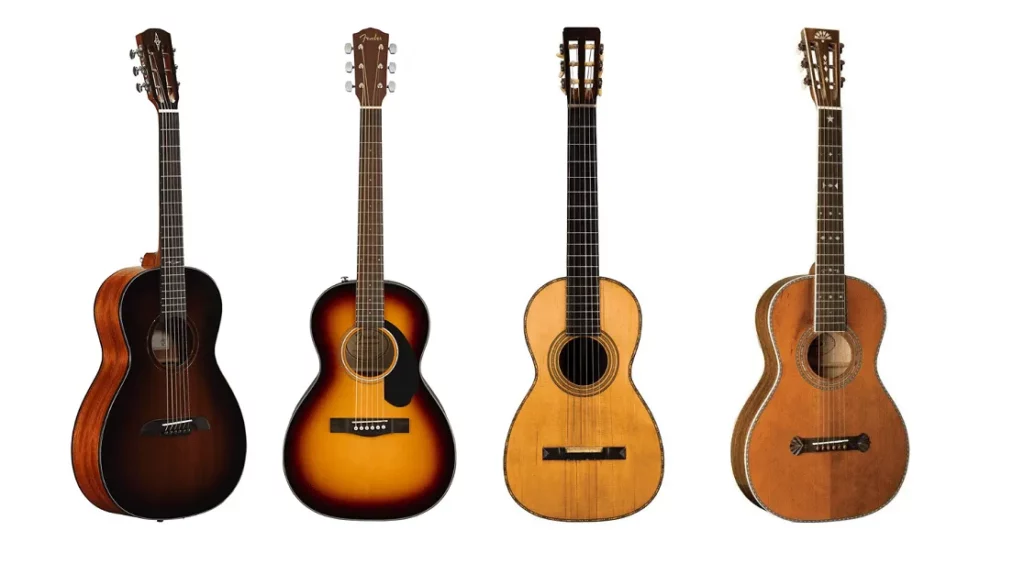
Ah, the acoustic guitar. A staple in many a musician’s arsenal, and a beloved instrument for countless listeners. But have you ever stopped to think about the size of your guitar? Or why it’s that size? Let’s dive deep into the world of the standard acoustic guitar size and see what makes it tick.
A Brief History of Acoustic Guitars
The acoustic guitar, with its harmonious tones and elegant design, has become an iconic instrument in the world of music. Its evolution from ancient civilizations to the modern concert stage tells a captivating story of artistry, innovation, and global influence. This article will journey through the ages to explore the rich history of acoustic guitars.
1. Ancient Origins:
While the modern acoustic guitar feels quintessentially Spanish, its roots trace back to ancient civilizations. Instruments resembling guitars were played thousands of years ago in regions ranging from Persia to India. The Greeks had the ‘kithara,’ and the Romans had the ‘cithara,’ which were both early precursors to the guitar.
2. The Moorish Influence:
Fast forward to medieval Spain, where the ‘guitarra morisca,’ an instrument introduced by the Moors, was popular. With a rounded back and several soundholes, it was distinctly different from the flat-backed guitars we know today but crucial in the guitar’s evolutionary journey.
3. Renaissance and Baroque Periods:
During the Renaissance, the four-stringed ‘guitarra latina’ was popular in Spain. By the Baroque period, five-course guitars (five pairs of strings) became the norm. These instruments were smaller than our modern guitars and were typically strummed rather than plucked.
4. The Classical Era:
By the late 18th century, the six-string guitar started to gain prominence. A pivotal figure of this era was Antonio de Torres Jurado, a Spanish guitar maker who, in the mid-1800s, made significant changes to the guitar’s design. He increased its size, adjusted its proportions, and used a fan bracing pattern under the top, leading to the louder, richer tones of the modern ‘classical’ guitar.
5. Steel-String Revolution:
While nylon strings (or their gut-string predecessors) were standard for classical guitars, the turn of the 20th century saw the rise of the steel-string guitar, particularly in the United States. The increased tension of steel strings required a sturdier build, leading to innovations like the truss rod to reinforce the neck. These guitars produced brighter and louder tones, suitable for a range of new music genres.
6. Iconic Brands and Mass Production:
The 20th century witnessed the birth and rise of iconic guitar brands like Martin, Gibson, and Taylor. With the industrial revolution and advances in production techniques, guitars became more accessible to the masses, solidifying their place in popular culture.
7. The Acoustic Guitar in Popular Music:
From the blues to rock ‘n’ roll, folk to pop, the acoustic guitar has proven its versatility. Artists like Bob Dylan, Joan Baez, and Eric Clapton have showcased the guitar’s expressive range, making it an integral part of the global music landscape.
From ancient strings to today’s finely crafted instruments, acoustic guitars have undergone a remarkable evolution. Their journey through time and cultures is a testament to humanity’s enduring love for music and the instruments that bring it to life. Today, the acoustic guitar stands not just as an instrument but as a symbol of global musical heritage.
The Standard Acoustic Guitar Size: What’s the Deal?

all length of approximately 38 inches (96.5 cm) and a scale length of around 25.5 inches (64.8 cm). These measurements are typical for a full sized guitar, which are suitable for most adult players.
But why this size? The development of these dimensions was a response to the instrument’s evolving popularity and the need for increased volume in various playing environments.
Now, if you’re thinking, “But I’ve seen so many different acoustic guitar sizes!”, you’re right. The world of acoustic guitars is vast, and there’s a size and shape for every guitar player out there.
The Many Faces of Acoustic Guitars
Dreadnought Guitars

The most popular shape and common acoustic guitar size is the dreadnought. These guitars are known for their loud sound and are often used in folk music. They have a larger body size, which contributes to their louder sound.
Standard Size & Dimensions: Dreadnoughts typically have a body length of around 20 inches, a width of about 15.75 inches, and a depth of roughly 4.75 inches.
Neck Shape: Wider neck compared to some other types.
Playing Styles: Perfect for bluegrass, rock, country, and pop. This shape provides a robust and bold tone.
Interesting Facts: Dreadnoughts are often the go-to for beginners due to their versatility and rich sound. Many intermediate and expert players continue to favor them for their powerful projection.
Parlor Guitars and Concert Guitars

Parlor guitars and concert guitars are a smaller sized guitar than dreadnoughts. They produce a softer sound, making them perfect for fingerstyle playing. These guitars are often chosen by players who prefer a more balanced sound.
Standard Size & Dimensions: Parlor guitars are smaller with a length of around 18 inches, a width of 13 inches, and a depth of 4.25 inches. Concert guitars are slightly larger than parlor but smaller than dreadnoughts.
Neck Shape: Slim necks which can be easier to navigate for some players.
Playing Styles: Suitable for fingerstyle and light strumming. These guitars are perfect for blues, folk, and country styles.
Interesting Facts: The compact size of parlor guitars makes them ideal for players with smaller stature, as well as those looking for a comfortable, portable option. Concert guitars are a favorite among intermediate players due to their balanced tone and responsiveness.
Jumbo and Grand Auditorium Guitars

For those who want a large guitar with a louder sound, jumbo or dreadnought guitars are the way to go. Grand auditorium guitars, sometimes known as a concert guitar, on the other hand, are versatile and suitable for various playing styles.
Standard Size & Dimensions: Jumbos are large-bodied guitars, with a length often surpassing 20 inches, width of around 17 inches, and depth nearing 5 inches. Grand Auditoriums lie somewhere between dreadnought and jumbo sizes.
Neck Shape: Varies, but generally wider, offering more space between strings.
Playing Styles: Ideal for players who want a full, room-filling sound. Great for aggressive strumming, fingerpicking, and flat-picking in genres like rock, country, and folk.
Interesting Facts: Jumbo guitars, with their large resonating bodies, are perfect for performers as they project loudly. Grand Auditoriums, with their curvier shape, tend to appeal to advanced players for their tonal versatility.
Classical Guitars
Ah, the classical guitar. Known for its nylon strings, it’s a favorite among classical music enthusiasts. A full-sized classical guitar is slightly different from other full-sized guitars, so it’s essential to compare guitars before making a choice.
Standard Size & Dimensions: Classical guitars come with a body length of around 19 inches, a width of 14.5 inches, and a depth of around 4 inches.
Neck Shape: Wider and flatter neck, often without inlays or markings.
Playing Styles: Specifically designed for classical and flamenco music, they’re perfect for fingerstyle techniques due to the nylon strings.
Interesting Facts: Favored by beginners for the softer nylon strings which are easier on the fingertips. However, the wide neck can be a challenge for some, making it suitable for intermediate and expert players committed to classical music.
Travel and Mini Guitars
For the guitar player on the go, travel and mini guitars are a godsend. They’re about half the size of a typical full-size guitar, making them perfect for trips. Don’t be fooled by their size, though; these scaled-down guitars still pack a punch!
Standard Size & Dimensions: As these are designed for portability, they vary in size but are significantly smaller than standard guitars. Commonly, they have a body length of around 15 inches, a width of 12 inches, and a depth of 3.25 inches.
Neck Shape: Typically a narrower neck for ease of play and transport.
Playing Styles: Suited for casual play, practice, and songwriting sessions on-the-go.
Interesting Facts: Despite their size, many mini guitars are built with quality in mind and can produce a sound that rivals bigger guitars. They’re great for beginners for practice sessions, but also favored by traveling musicians of all skill levels.
Understanding the Scale Length of Full-Size Guitars: A Beginner’s Primer

When diving into the world of guitars, a beginner might be overwhelmed by the sheer variety and terminology. Among electric and acoustic guitars, the term “scale length” often pops up. But what exactly does it mean, especially for a full-size guitar?
Scale Length: The Basics
The scale length of a guitar is the distance between the nut (the piece near the top of the fretboard) and the saddle (located on the bridge of the guitar). In essence, it’s the portion of the string that vibrates and produces sound.
Standard Scale Length for Acoustic Guitars
For full-size guitars, especially acoustic ones, the standard scale length typically falls between 24.75 inches to 25.5 inches. However, it’s essential to note that the size of a guitar doesn’t solely depend on its scale length. The body depth, width, and overall design play crucial roles in determining the guitar’s size.
Delving Deeper: Different Guitar Types and Their Scale Lengths
- Electric and Acoustic Guitars: While both these categories can have full-size guitars, their scale lengths might slightly differ. Electric guitars can sometimes have shorter scales, making them a tad easier to play for beginners.
- Classical Guitars: Often strung with nylon strings, classical guitars usually have a scale length around 25.6 inches. The softer nylon strings are gentle on beginner fingers, but the wider neck might pose challenges.
- Parlor Guitars: Smaller than your full-size acoustic guitar, parlor guitars have been historically popular for their portability. They don’t necessarily have a standard scale length but are often shorter than the big jumbo or dreadnought guitars.
- Concert Guitars: Slightly larger than parlor guitars, concert guitars offer a balanced tone. Their scale length often leans towards the standard of a full-size guitar.
- Jumbo Acoustic Guitar: As the name suggests, these are large-bodied guitars known for their powerful sound. They usually stick close to the standard scale length mentioned above.
- Steel Strings vs. Nylon Strings: While steel strings are commonly found on most acoustic and electric guitars, classical guitars typically use nylon strings. Steel strings offer a bright and loud sound, whereas nylon provides a softer and mellower tone.
- Jumbo or Dreadnought Guitars: These are the big boys in the acoustic world. Dreadnoughts, in particular, are among the most popular and are considered by many as the standard full-size guitar.
- Bass Guitars: These are a different beast altogether. Typically longer than acoustic guitars, bass guitars are designed to play low frequencies.
What’s in the Size?
While a full-size guitar is often recommended for adults, remember that “full size” isn’t standardized across all guitar types. A jumbo acoustic guitar is considerably larger in body depth and size than a parlor guitar, even if both might be considered full size in their categories.
As you journey from parlor guitars to jumbo or dreadnought guitars, remember that the size of a guitar, its string type (steel or nylon strings), and its scale length all play a role in its playability and sound. Whether you’re gravitating towards electric and acoustic guitars or have an affinity for bass guitars, understanding these nuances will ensure a harmonious journey into the world of music.
The Electric Guitar: A Different Beast

While we’re on the topic of guitars, let’s not forget about electric guitars. Electric guitars tend to be slimmer than acoustic guitars. The size of a guitar can influence its sound, and with electric guitars, the electronics play a significant role. For a deep dive into the differences between electric and acoustic guitars, check out this comprehensive guide.
Factors Influencing Guitar Size
Several factors can influence the size of a guitar:
- Playing Style: A fingerstyle player might prefer a smaller guitar, while a strummer might opt for larger guitars.
- Body Depth: A deeper body depth can produce a louder sound.
- Body Length: A longer body can affect the guitar’s resonance and volume.
- Neck Shape: The shape of the guitar’s neck can influence playability. For more on this, explore the different guitar neck shapes.
Buying Your First Guitar: A Comprehensive Guide
Stepping into the world of music by buying your first guitar is an exhilarating experience. The six strings of a guitar carry with them a promise of joy, creativity, and perhaps even a lifelong passion. However, with the vast array of options available, the journey to buy one can seem daunting. Here’s a guide to help you navigate through this maze.
1. Determine Your Budget:
Before you venture into any store or online marketplace, determine a budget. Guitars range from very affordable to exceedingly expensive. Having a clear budget will help you narrow down your options and avoid overspending.
2. Acoustic vs. Electric:
Though this article focuses on acoustic guitars, it’s essential to know the difference. Acoustic guitars are great for beginners because they require no additional equipment. Electrics, while versatile, need amplifiers and cables. For beginners keen on learning the basics, an acoustic is often recommended.
3. Size Matters:
Especially for younger players or those with a smaller build, the size of the guitar is crucial.
- Full-Size Guitars: Best for adults and older teenagers.
- 3/4 Size Guitars: Suitable for tweens or if you’re slightly smaller in stature.
- Quarter or Half Size Guitar: Ideal for children below 12.
4. Tonewood and Build Quality:
The type of wood and the guitar’s build significantly affect its tone. Spruce, mahogany, and rosewood are popular choices. For beginners, it’s good to start with a solid top guitar, as they offer better sound quality than laminate tops.
5. Play Before You Pay:
If possible, visit a local music store and try out some guitars. Feel the neck, listen to the sound, and see what resonates with you. A guitar should feel comfortable in your hands.
6. Read Reviews and Research Brands:
While personal comfort with the instrument is paramount, the reputation of brands and models also matters. Read reviews, ask for recommendations, and research before making a decision.
High-Quality Standard Sized Acoustic Guitars for Beginners:
- Yamaha FG800: An excellent choice for beginners, known for its durability and sound quality.
- Taylor GS Mini: While slightly on the pricier side for beginners, its impeccable sound and build quality make it worth every penny.
- Fender CD-60S: An affordable option from a reputable brand, suitable for new players.
- Martin LX1 Little Martin: Compact and known for its warm tones, it’s a great starting point for budding guitarists.
- Epiphone DR-100: A budget-friendly option with a decent sound profile for those starting their musical journey.
- Seagull S6 Original: A bit of an investment, but its rich tones and excellent craftsmanship make it a favorite among many.
In Conclusion

The world of acoustic guitar sizes is vast and varied. From the jumbo acoustic guitar to the parlor guitar, there’s something for every guitar player out there. Whether you’re a seasoned musician or just starting, understanding the standard acoustic guitar size and its variations can help you find the perfect instrument for your needs.
Remember, the size of a guitar isn’t just about aesthetics; it can influence the sound, playability, and overall experience. So, the next time you pick up your guitar, take a moment to appreciate its size and the history behind it.


